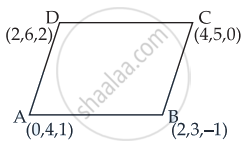Advertisements
Advertisements
Question
The area of the quadrilateral ABCD, where A(0,4,1), B(2, 3, –1), C(4, 5, 0) and D(2, 6, 2), is equal to ______.
Options
9 sq.units
18 sq.units
27 sq.units
81 sq.units
Solution
The area of the quadrilateral ABCD, where A(0,4,1), B(2, 3, –1), C(4, 5, 0) and D(2, 6, 2), is equal to 9 sq.units.
Explanation:

Given points are A(0, 4, 1), B(2,3,– 1), C(4, 5, 0) and D(2,6,2)
D’ratios of AB = 2,–1 –2
And d’ratios of DC = 2,–1,–2
∴ AB||DC
Similarly, d’ratios of AD = 2, 2, 1 and d’ratios of BC = 2, 2, 1
∴ AD || BC
So ABCD is a parallelogram
`vec"AB" = 2hat"i" - hat"j" - 2hat"k"`
`vec"AD" = 2hat"i" + 2hat"j" + hat"k"`
∴ Area of parallelogram ABCD = `|vec"AB" xx vec"AD"|`
= `|(hat"i", hat"j", hat"k"),(2, -1, -2),(2, 2, 1)|`
= `hat"i"(-1 + 4) - hat"j"(2 + 4) + hat"k"(4 + 2)`
= `3hat"i" - 6hat"j" + 6hat"k"`
= `sqrt((3)^2 + (-6)^2 + (6)^2)`
= `sqrt(9 + 36 + 36)`
= `sqrt(81)`
= 9 sq.units
APPEARS IN
RELATED QUESTIONS
Which of the following represents direction cosines of the line :
(a)`0,1/sqrt2,1/2`
(b)`0,-sqrt3/2,1/sqrt2`
(c)`0,sqrt3/2,1/2`
(d)`1/2,1/2,1/2`
Find the angle between the lines whose direction ratios are 4, –3, 5 and 3, 4, 5.
Find the vector equation of the plane passing through (1, 2, 3) and perpendicular to the plane `vecr.(hati + 2hatj -5hatk) + 9 = 0`
Find the angle between the vectors whose direction cosines are proportional to 2, 3, −6 and 3, −4, 5.
Show that the points (2, 3, 4), (−1, −2, 1), (5, 8, 7) are collinear.
Show that the line through points (4, 7, 8) and (2, 3, 4) is parallel to the line through the points (−1, −2, 1) and (1, 2, 5).
Show that the line joining the origin to the point (2, 1, 1) is perpendicular to the line determined by the points (3, 5, −1) and (4, 3, −1).
What are the direction cosines of Z-axis?
Write the distance of the point (3, −5, 12) from X-axis?
Write the inclination of a line with Z-axis, if its direction ratios are proportional to 0, 1, −1.
Write the angle between the lines whose direction ratios are proportional to 1, −2, 1 and 4, 3, 2.
Find the distance of the point (2, 3, 4) from the x-axis.
Answer each of the following questions in one word or one sentence or as per exact requirement of the question:
Write the distance of a point P(a, b, c) from x-axis.
For every point P (x, y, z) on the xy-plane,
A rectangular parallelopiped is formed by planes drawn through the points (5, 7, 9) and (2, 3, 7) parallel to the coordinate planes. The length of an edge of this rectangular parallelopiped is
The distance of the point P (a, b, c) from the x-axis is
If a line makes angles α, β, γ, δ with four diagonals of a cube, then cos2 α + cos2 β + cos2γ + cos2 δ is equal to
Find the equation of the lines passing through the point (2, 1, 3) and perpendicular to the lines
Find the direction cosines of a vector whose direction ratios are
`1/sqrt(2), 1/2, 1/2`
If (a, a + b, a + b + c) is one set of direction ratios of the line joining (1, 0, 0) and (0, 1, 0), then find a set of values of a, b, c
Choose the correct alternative:
The unit vector parallel to the resultant of the vectors `hat"i" + hat"j" - hat"k"` and `hat"i" - 2hat"j" + hat"k"` is
Find the direction cosines of the line passing through the points P(2, 3, 5) and Q(–1, 2, 4).
If α, β, γ are the angles that a line makes with the positive direction of x, y, z axis, respectively, then the direction cosines of the line are ______.
O is the origin and A is (a, b, c). Find the direction cosines of the line OA and the equation of plane through A at right angle to OA.
Find the direction cosine of a line which makes equal angle with coordinate axes.
The co-ordinates of the point where the line joining the points (2, –3, 1), (3, –4, –5) cuts the plane 2x + y + z = 7 are ______.
The projections of a vector on the three coordinate axis are 6, –3, 2 respectively. The direction cosines of the vector are ______.
If a line makes angles of 90°, 135° and 45° with the x, y and z axes respectively, then its direction cosines are ______.
Find the coordinates of the image of the point (1, 6, 3) with respect to the line `vecr = (hatj + 2hatk) + λ(hati + 2hatj + 3hatk)`; where 'λ' is a scalar. Also, find the distance of the image from the y – axis.
